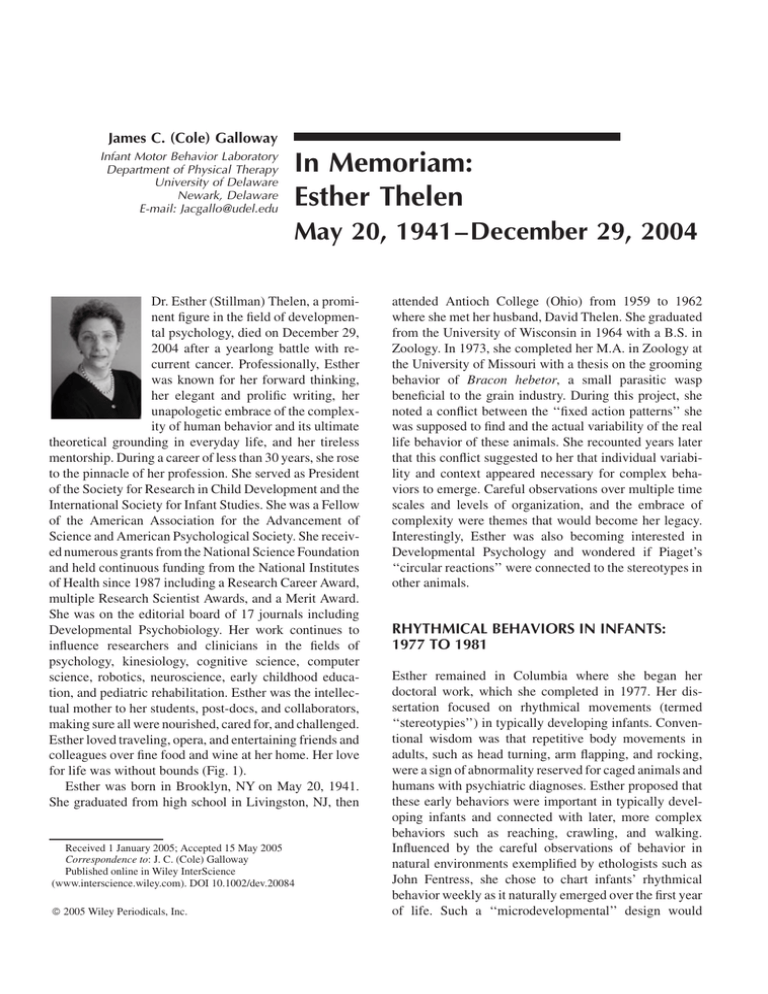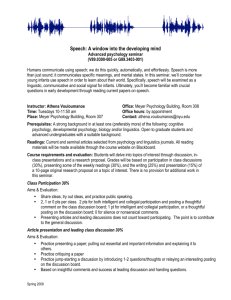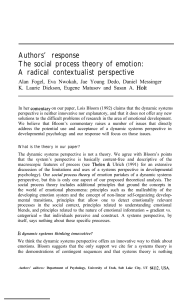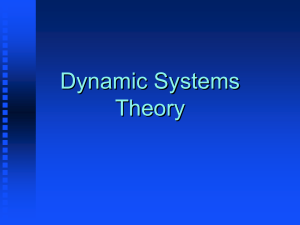In Memoriam: Esther Thelen James C. (Cole) Galloway
advertisement

James C. (Cole) Galloway Infant Motor Behavior Laboratory Department of Physical Therapy University of Delaware Newark, Delaware E-mail: Jacgallo@udel.edu In Memoriam: Esther Thelen May 20, 1941–December 29, 2004 Dr. Esther (Stillman) Thelen, a prominent figure in the field of developmental psychology, died on December 29, 2004 after a yearlong battle with recurrent cancer. Professionally, Esther was known for her forward thinking, her elegant and prolific writing, her unapologetic embrace of the complexity of human behavior and its ultimate theoretical grounding in everyday life, and her tireless mentorship. During a career of less than 30 years, she rose to the pinnacle of her profession. She served as President of the Society for Research in Child Development and the International Society for Infant Studies. She was a Fellow of the American Association for the Advancement of Science and American Psychological Society. She received numerous grants from the National Science Foundation and held continuous funding from the National Institutes of Health since 1987 including a Research Career Award, multiple Research Scientist Awards, and a Merit Award. She was on the editorial board of 17 journals including Developmental Psychobiology. Her work continues to influence researchers and clinicians in the fields of psychology, kinesiology, cognitive science, computer science, robotics, neuroscience, early childhood education, and pediatric rehabilitation. Esther was the intellectual mother to her students, post-docs, and collaborators, making sure all were nourished, cared for, and challenged. Esther loved traveling, opera, and entertaining friends and colleagues over fine food and wine at her home. Her love for life was without bounds (Fig. 1). Esther was born in Brooklyn, NY on May 20, 1941. She graduated from high school in Livingston, NJ, then Received 1 January 2005; Accepted 15 May 2005 Correspondence to: J. C. (Cole) Galloway Published online in Wiley InterScience (www.interscience.wiley.com). DOI 10.1002/dev.20084 ß 2005 Wiley Periodicals, Inc. attended Antioch College (Ohio) from 1959 to 1962 where she met her husband, David Thelen. She graduated from the University of Wisconsin in 1964 with a B.S. in Zoology. In 1973, she completed her M.A. in Zoology at the University of Missouri with a thesis on the grooming behavior of Bracon hebetor, a small parasitic wasp beneficial to the grain industry. During this project, she noted a conflict between the ‘‘fixed action patterns’’ she was supposed to find and the actual variability of the real life behavior of these animals. She recounted years later that this conflict suggested to her that individual variability and context appeared necessary for complex behaviors to emerge. Careful observations over multiple time scales and levels of organization, and the embrace of complexity were themes that would become her legacy. Interestingly, Esther was also becoming interested in Developmental Psychology and wondered if Piaget’s ‘‘circular reactions’’ were connected to the stereotypes in other animals. RHYTHMICAL BEHAVIORS IN INFANTS: 1977 TO 1981 Esther remained in Columbia where she began her doctoral work, which she completed in 1977. Her dissertation focused on rhythmical movements (termed ‘‘stereotypies’’) in typically developing infants. Conventional wisdom was that repetitive body movements in adults, such as head turning, arm flapping, and rocking, were a sign of abnormality reserved for caged animals and humans with psychiatric diagnoses. Esther proposed that these early behaviors were important in typically developing infants and connected with later, more complex behaviors such as reaching, crawling, and walking. Influenced by the careful observations of behavior in natural environments exemplified by ethologists such as John Fentress, she chose to chart infants’ rhythmical behavior weekly as it naturally emerged over the first year of life. Such a ‘‘microdevelopmental’’ design would 104 Galloway become yet another characteristic of Thelen projects. In 1977, she joined the Department of Psychology at Missouri. In a series of publications from 1979 to 1981, she showed these early movements to be complex, context dependent, tractable behaviors emerging in real time. This series also signaled to the field that a born writer had arrived, one with a knack for connecting the data to the reader, and leaving the reader with a new view of the world. By 1981, she was an Assistant Professor at Missouri, where she would stay until 1985. Although she never stopped viewing behavior with an ethologist’s eye, infant developmental psychology would be her professional home for the remainder of her career. LEG BEHAVIORS IN INFANTS: 1981 TO 2002 Newborn Kicking and Stepping Historically, early infant movements were viewed as reflecting neural circuitry largely isolated from experience and learning. In light of her work in rhythmical movements, Esther viewed these behaviors as much more complex than a reflex model suggested. Specifically, Esther observed that early kicking and the newborn ‘‘stepping reflex’’ looked similar, yet kicking persisted throughout the first 6 months of life whereas the reflex ‘‘disappeared.’’ In a now classic series of studies (often referred to as ‘‘The Case of the Disappearing Reflex’’), she examined newborn stepping and kicking throughout the first months of life. The results now fill textbooks on developmental psychology, neuromotor control, as well as pediatric physical therapy. By systematically varying the weight of the legs, making them heavier via small weights or lighter via submersion in water, she was able to make the ‘‘reflex’’ disappear or reappear. Taking these results together, she showed that the reflex disappeared, not due to cortical maturation, but rather due to a rapid increase in leg fat relative to leg muscle mass. The largely untested neural explanation had fallen under the weight of a few simple manipulations of peripheral factors. Treadmill Stepping and Instrumented Learning Esther’s interest in context dependency and the infant– environment interplay led her to study the interaction between infants and two novel environments: treadmills and mobiles. Although she had written about multicausality in previous projects, Bev Ulrich recalls that it was during the treadmill projects that Esther began to leave singular developmental causation behind and move more strongly toward viewing development as an interplay of multiple systems. During this time, discus- sions with Gerald Edelman regarding Neural Darwinism reinforced her view of development. In Carolyn Rovee Collier’s associative learning paradigm, infants’ kicks result in movement of an overhead mobile. Esther used the mobile paradigm to study how infants explore and select patterns of leg movement to control the mobile’s movement. These results advanced our understanding of how infants overlay purposeful behaviors on their ongoing spontaneous movements, and led to the use of the mobile paradigm with infants at risk for learning and coordination impairments. Through the detailed observations of relatively simple leg behaviors, Esther began to formally express in theoretical and empirical papers many of her most well known principles: Even the earliest behaviors emerge from multiple, interacting factors including the nervous system, the body’s mechanical properties, and the social and physical environment. Development emerges across multiple time scales from seconds and minutes to weeks and years. Individual differences contain the reality of development. Context and task, as perceived by the infant (not the adult experimenter), are essential to developmental theory. Application of Dynamic Systems to Infant Development In 1985, Esther moved to Indiana University as a Professor of Psychology. It was here that she began in earnest to meld the theoretical and empirical work on Dynamic Systems of Scott Kelso and Peter Kugler, and Ecological Psychology as proposed by Michael Turvey and others with her own work in Developmental Psychology. With increasing focus, she began to think, write, and discuss the application of systems theory first to developmental psychology and then expand to other fields within the biological and behavioral sciences as well as pediatric and adult rehabilitation. She would go on to become synonymous with a Dynamic Systems approach to development. REACHING IN INFANTS: 1990 TO 2004 Between 3 and 5 months of age, infants begin to independently explore and manipulate their immediate environment by reaching for objects. Reaching and Esther were a perfect match. On one hand, the literature on the development of reaching relied on maturational theories, was focused on the role of vision, and generally lacked detailed observations. On the other hand, Esther needed a In Memoriam model system to study the specifics of context dependent and self-organized development. It was to be a perfect marriage of a complex system and a scientist who embraced complexity. In this series of studies, all her theoretical, experimental, and observational skills became focused on a motor behavior she viewed as more than movement. In 1990, she and half a dozen colleagues and students took aim at understanding how infants adapt their ongoing arm movements for reaching. Addressing the questions to Esther’s satisfaction meant systematically viewing the behavior at many levels as often as possible. Esther’s vision required state of the art technology complete with high-speed motion analysis, surface electromyography, and multiple sessions per month with each baby throughout the first year of life. For the research team, this demanded the quick and efficient placement of up to ten surface electrodes and infrared markers on small and squirmy subjects, then maintaining each infant (and family) at a motivated and ready state—all the while working with motion capture technology designed for adult gait analysis not babies. The Herculean effort paid off. In the multiple theoretical and empirical papers that emerged, Esther and her coworkers provided a story of how a behavior emerges from the complex and ongoing interplay of arousal, attention, motivation, biomechanics, neuromotor control, muscle performance, head-arm-trunk posture, and experience. Certain papers focused on unimanual coordination while others focused on the complex development of bimanual control and lateral bias. There were papers on hand and joint motion, the relationship between muscle activities and motion, and the role of movement speed. The composite theme of this work was how individual infants solve common control problems in their own way and in their own time. This work immediately found widespread appeal and was published in journals ranging from the Journal of Neurophysiology, Journal of Motor Behavior, and Developmental Psychobiology to Child Development and Infancy. This work remains the most comprehensive collection on the development of reaching. THE A NOT B ERROR, DYNAMIC FIELD THEORY AND BEYOND In the classic A not B paradigm, 7–12 month old infants reach multiple times for a hidden object at one location (A), then choose to reach back to A when the object is clearly hidden in another location (B). Traditionally, the focus has been on the hidden object with more recent work linking the error to the development of specific areas of the nervous system. In classic form, Esther and colleague Linda Smith focused on the behavioral details leading up 105 to the emergence of the error—specifically the multiple reaches to location A prior to the object being hidden in location B. In a series of experiments that continues today, they showed that: (a) the A not B error can occur without an object, (b) that the probability of the A not B error is linked to the number of reaches to the A location, and (c) that multiple factors, from the saliency and number of target locations to even the biomechanical properties of the arms, influence whether an infant makes the error. Esther viewed the A not B error as emerging from the continuous interplay of task input, habit and memory during real time. This view was formalized in work with Gregor Schöner using his Dynamic Field Theory. At the time of her death, Esther was beginning a series of empirical and modeling studies looking at the real time emergence of looking behaviors such as those seen in visual habituation paradigms. Both A not B and visual habituation were model systems for Esther to understand the specifics of her message of embodied development. Specifically, that perception, action and cognition form an integrated system, which cannot be partitioned. Although Esther was most well known in infant development circles, she advanced the understanding of human behavior on a much wider scale. She published theoretical and empirical work in the neuromotor control of skilled behaviors such as playing the cello, rehabilitation including physical therapy, occupational therapy, and Feldenkrais movement education, and the emerging field of developmental robotics. To each of these, she brought the same energy, passion, and messages. The positive message was that the behavior of complex systems emerges in real time due to the interplay of many factors. The warning was that theories built on artificial partitioning, theoretical reductionism or disembodied mental functions will ultimately fail to address the issue of change. Another source of her widespread impact was her knack for creating experimental designs that were simple enough for young infants but which also addressed larger theoretical issues. These included babies in fish tanks, babies with weights or shining garments on their legs, babies offered toys to their feet, and babies stepping on split belt treadmills. In closing, I borrow from J. Lemke’s review of A Dynamic Systems Approach to Development written by Esther and Linda Smith. Here he is discussing the basic questions raised by applying dynamic systems to the behavioral sciences: ‘‘These are not merely technical questions of some esoteric branch of developmental psychology . . . They are problems that challenge the ruling paradigms of today’s perceptual, motor, and cognitive psychologies . . . Once you make the jump to this new way of looking at the issue, it is hard not to 106 Galloway suspect a deep cultural bias in our traditional intuitions about the origins of order . . . This shift in perspective makes such notions as ‘‘situated cognition’’ or ‘‘social cognition’’ less paradoxical: the system in which cognitive or semiotic activity is taking place is larger than that of individual human organisms. We no longer have the option of localizing a source for the order of behavior at all, much less in one part of the total system of relevance.’’ Reflecting on Esther’s professional impact at her memorial service on the Indiana University campus in Bloomington, Michael Turvey said simply that ‘‘she moved her science.’’ Indeed she did and so much more. Esther is survived by her husband (David), her daughter (Jennifer), her son (Jeremy), her sister (Harriet Saeck), and her grandson (Jackson). The Esther Thelen Memorial Fund promotes the interaction of scientists, practitioners, parents, and policymakers to discuss how the dynamic view of development Esther championed can make children’s lives better (To contribute, contact Indiana University Foundation, c/o IU Psychology Department, 1101 E. 10th St., Bloomington, IN 47405). SELECTED BIBLIOGRAPHY Animal Behavior Thelen, E., & Farish, D. J. (1977). An analysis of the grooming behavior of wild and mutant strains of Bracon hebetor (Braconidae: Hymenoptera). Behaviour, 62, 699–715. Ronca, A. E., Kamm, K., Thelen, E., & Alberts, J. R. (1994). Proximal control of fetal rat behavior. Developmental Psychobiology, 27, 23–38. Infant Stereotypies Thelen, E. (1979). Rhythmical stereotypies in normal human infants. Animal Behaviour, 27, 699–715. Thelen, E. (1980). Determinants of amounts of stereotyped behavior in normal human infants. Ethology and Sociobiology, 1, 141–150. Thelen, E. (1981). Kicking, rocking, and waving: Contextual analysis of stereotyped behaviour in normal infants. Animal Behaviour, 29, 3–11. Thelen, E. (1981). Rhythmical behavior in infancy: An ethological perspective. Developmental Psychology, 17, 237–257. Kicking and Stepping Thelen, E., & Fisher, D. M. (1982). Newborn stepping: An explanation for a ‘‘disappearing’’ reflex. Developmental Psychology, 18, 760–775. Thelen, E., Fisher, D. M., Ridley-Johnson, R., & Griffin, N. (1982). The effect of body build and arousal on newborn infant stepping. Developmental Psychobiology, 15, 447–453. Thelen, E., & Fisher, D. M. (1983). The organization of spontaneous leg movements in newborn infants. Journal of Motor Behavior, 15, 353–377. Thelen, E., Ridley-Johnson, R., & Fisher, D. (1983). Shifting patterns of bilateral coordination and laterality in the leg movements of young infants. Developmental Psychobiology, 17, 29–46. Thelen, E., Fisher, D. M., & Ridley-Johnson, R. (1984). The relationship between physical growth and a newborn reflex. Infant Behavior & Development, 7, 479–493. Thelen, E. (1985). Developmental origins of motor coordination: Leg movements in human infants. Developmental Psychobiology, 18, 1–22. Jensen, J. L., Ulrich, B. D., Thelen, E., Schneider, K., & Zernicke, R. F. (1994). Adaptive dynamics of the leg movement patterns of human infants: I. The effects of posture on spontaneous kicking. Journal of Motor Behavior, 26, 303– 312. Jensen, J. L, Ulrich, B. D., Thelen, E., Schneider, K., & Zernicke, R. F. (1995). Adaptive dynamics of the leg movement patterns of human infants: III. Age-related differences in limb control. Journal of Motor Behavior, 27, 366–374. Treadmill Stepping and Instrumented Learning Thelen, E., & Fisher, D. M. (1983). From spontaneous to instrumental behavior: Kinematic analysis of movement changes during very early learning. Child Development, 54, 129–140. Thelen, E. (1986). Treadmill-elicited stepping in seven-monthold infants. Child Development, 57, 1498–1506. Thelen, E., Ulrich, B. D., & Niles, D. (1987). Bilateral coordination in human infants: Stepping on a split-belt treadmill. Journal of Experimental Psychology: Human Perception and Performance, 13, 405–410. Ulrich, B. D., Jensen, J. L., Thelen, E., Schneider, K., & Zernicke, R. F. (1994). Adaptive dynamics of the leg movement patterns of human infants. II. Treadmill stepping in infants and adults. Journal of Motor Behavior, 26, 313–324. Vereijken, B., & Thelen, E. (1997). Training infant treadmill stepping: The role of individual pattern stability. Developmental Psychobiology, 30, 89–102. Thelen, E. (1994). Three-month-old infants can learn taskspecific patterns of interlimb coordination. Psychological Science, 5, 280–285. Angulo-Kinzler, R., Ulrich, B. D., & Thelen, E. (2002). Threemonth-old infants can select specific motor solutions. Motor Control, 6, 52–68. Dynamic Systems Thelen, E., Kelso, J. A. S., & Fogel, A. (1987). Self-organizing systems and infant motor development. Developmental Review, 7, 39–65. Thelen, E., Skala, K., & Kelso, J. A. S. (1987). The dynamic nature of early coordination: Evidence from bilateral leg movements in young infants. Developmental Psychology, 23, 179–186. Fogel, A., & Thelen, E. (1987). The development of expressive and communicative action in the first year: Reinterpreting the evidence from a dynamic systems perspective. Developmental Psychology, 23, 747–761. Thelen, E. (1992). Development as a dynamic system. Current Directions in Psychological Science, 1, 189–193. In Memoriam Smith, L. B., & Thelen, E. (Eds.) ( 1993). Dynamic systems in development: Applications. Cambridge MA: Bradford Books/MIT Press. Thelen, E., & Smith, L. B. (1994). A dynamic systems approach to the development of cognition and action. Cambridge, MA: Bradford Books/MIT Press. Smith, L.B., & Thelen, E. (2003). Development as a dynamic system. Trends in Cognitive Sciences, 7(8), 343–348. Infants at Risk for Coordination Impairments Thompson, D. F., & Thelen, E. (1986). The effects of supplemental vestibular stimulation on stereotyped behavior and development in normal infants. Physical & Occupational Therapy in Pediatrics, 6, 57–66. Kamm, K., Thelen, E., & Jensen, J. L. (1990). A dynamical systems approach to motor development. Physical Therapy, 70, 763–775. Davis, D. W. & Thelen, E., & Keck, J. (1994). Treadmillelicited stepping in infants born prematurely. Early Human Development, 39, 211–223. Thelen, E. (2004). The central role of movement in typical and atypical development. In Stockman, I. J. (Ed.) Movement and action in learning and development: Clinical implications for pervasive developmental disorders. Academic Press. Reaching Thelen, E., Corbetta, D., Kamm, K., Spencer, J. P., Schneider, K., & Zernicke, R. F. (1993). The transition to reaching: Mapping intention and intrinsic dynamics. Child Development, 64, 1058–1098. Corbetta, D., & Thelen, E. (1995). A method for identifying the initiation of reaching movements in natural prehension. Journal of Motor Behavior, 27, 285–293. Corbetta, D., & Thelen, E. (1996). The developmental origins of bimanual coordination. Journal of Experimental Psychology Human Perception and Performance, 22, 502–522. Thelen, E., Corbetta, D., & Spencer, J. P. (1996). The development of reaching during the first year: The role of movement speed. Journal of Experimental Psychology Human Perception and Performance, 22, 1059–1076. Corbetta, D., & Thelen, E. (1999). Lateral biases and fluctuations in infants arm movements and reaching. Developmental Psychobiology, 34, 237–255 Zaal, F. T. J. M., Daigle, K., Gottlieb, G., & Thelen, E. (1999). An unlearned principle for controlling natural movements. Journal of Neurophysiology, 82, 255–259. 107 Spencer, J. P., & Thelen, E. (2000). Spatially specific changes in infants muscle co-activity as they learn to reach. Infancy, 1, 275–302. Spencer, J. P., Vereijken, B., Diedrich, F.J., & Thelen, E. (2000). Posture and the emergence of manual skills. Developmental Science 3, 216–233. Corbetta, D., Thelen, E., & Johnson, K. (2001). Motor constraints on the development of perception–action matching in infant reaching. Infant Behavior and Development, 23, 351– 374. Galloway, JC, & Thelen, E. (2004). Feet first: Object exploration in young infants. Infant Behavior and Development, 27, 107–112. A Not B, and Dynamic Field Theory Smith, L.B., Thelen, E., Titzer, R., & McLin, D. (1999). Knowing in the context of acting: The task dynamics of the A-not-B error. Psychological Review, 106, 235–260. Diedrich, F. J., Thelen, E., Smith, L. B., & Corbetta, D. (2000). Motor memory is a factor in infant perseverative errors. Developmental Science, 3, 479–494. Diedrich, F. J., Highlands, T., Spahr, K., Thelen, E, & Smith, L.B. (2001). The role of target distinctiveness in infant perseverative reaching errors. Journal of Experimental Child Psychology, 78, 263–290. Spencer, J. P., Smith, L.B., & Thelen, E. (2001). Tests of a dynamic systems account of the A-not-B error: The influence of prior experience on spatial memory abilities of two-yearolds. Child Development, 72, 1327–1346. Thelen, E., Schöner, G., Scheier, C., & Smith, L. B. (2001). The dynamics of embodiment: A field theory of infant perseverative reaching. Behavioral and Brain Sciences, 24, 1–34. Thelen, E., Schöner, G., Scheier, C., & Smith, L. B. (2001). What’s a modeler to do? Response to the commentaries. Behavioral and Brain Sciences, 24, 70–86. Schöner, G., & Thelen, E. (in press). Using dynamic field theory to rethink infant habituation. Psychological Review. Robots and Beyond Winold, H., Thelen, E., & Ulrich, B. D., (1993). Coordination and control in the bow arm movements of highly skilled cellists. Ecological Psychology, 6, 1–31. Weng, J., McClelland, J., Pentland, A., Sporns, O., Stockman, I., Sur, M., & Thelen, E. (2001) Artificial intelligence. Autonomous mental development by robots and animals. Science, Jan 26; 291(5504), 599–600.




